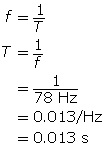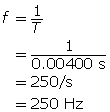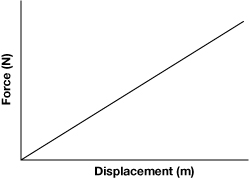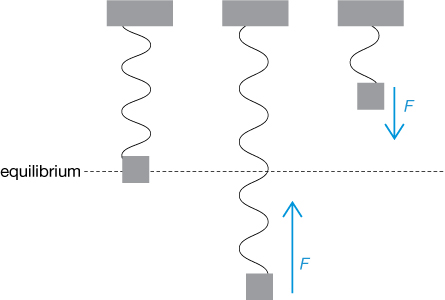Module 7—Oscillatory Motion
 Explore
Explore
Oscillatory Motion

© alle/shutterstock
What does a flying insect have in common with a guitar? Not much, you would think, but they both make sound. What about flying birds, idling car engines, electrical transformer boxes, fridges, freezers, electric shavers, and lawnmowers? They, too, produce steady sounds when they are in operation. This is because they oscillate with a constant frequency (f). An oscillation is one complete cycle of a motion or vibration. For example, the wings of an insect move up and down, completing one cycle every time they reach their original starting position. The cycle of a guitar string occurs in much the same way—the string moves up, then down, and then returns to its original starting position. Recall from Module 5: Lesson 1 that the number of cycles that occur in a certain amount of time is called the frequency (f). If the time period is one second, the frequency is measured in hertz (Hz).
frequency = cycles per time period
1 Hz = 1 cycle/second
1 Hz = 1/s
oscillate: to move back and forth at a constant rate
The time required to complete one cycle, which is known as the period (T), is the reciprocal of the frequency. Frequency and period are related mathematically by the following equation:
![]()
Consider an electrical transformer that vibrates with a constant frequency of
60 Hz. What is the cause of this vibration? The alternating current flowing in the windings (the electrical wires) of the transformer causes the vibration. In Alberta, that current makes the change from positive to negative and back to positive, one complete cycle, 60 times every second; therefore, the frequency of vibration is 60 Hz. The period of vibration is 1/60 Hz = 0.0167 s. This means the electrical current reverses direction twice every 0.0167 s.
 Read
Read
Read pages 344 to 347 in your textbook to review how frequency and period are converted from one to another.
 Self-Check
Self-Check
SC 1. Complete question 2 of “Practice Problems” on page 345 of your textbook.
SC 2. Complete question 9 of “7.1 Check and Reflect” on page 347 of your textbook.
SC 3. Complete “7-3 QuickLab: Determining the Stiffness of a Spring” beginning on page 348 of your textbook with another student, friend, or family member. Ask your teacher for the materials. Then complete questions 1, 2, 3, 4, and 5 on page 349.
 Self-Check Answers
Self-Check Answers
SC 1.
Given
f = 78 Hz
Required
the period of the wings motion (T)
Analysis and Solution

Paraphrase
The period of the hummingbird wing’s motion is 0.013 s.
SC 2.
Given
T= 0.00400 s
Required
the frequency of the guitar string (f)
Analysis and Solution

Paraphrase
The frequency of the guitar string is 250 Hz.
SC 3.
- Controlled variables include the spring selected, the horizontal orientation, and the surface of the table. The manipulated variable is the displacement of the spring, and the responding variable is the force applied.
- The following is a sample graph. Scales and slope will vary with the spring chosen.

- The line of best fit is a linear relationship.
- The slope should be taken from the line of best fit, not from individual data points.

The units for the slope will be N/m.
- The line should intercept the horizontal axis at 0 because there is no force applied, so the spring should not be stretched and the displacement should be zero.
Simple Harmonic Motion and Hooke’s Law
equilibrium position: the position where the resultant of all forces acting is zero
restoring force: a force that causes an object to return to an equilibrium position
simple harmonic motion: a repeating motion about a central equilibrium point caused by restoring forces
A guitar will not produce music unless someone is playing it. So what does it mean to “play” a guitar? Essentially, the player has to apply a series of forces to the strings, “plucking” them with a pick or finger. This force disturbs the string, causing it to deform or stretch from the equilibrium position. When this is done, the spring stores energy, and a restoring force acts to return the string to its equilibrium position. Whenever a restoring force is present, the oscillatory motion is called simple harmonic motion. For example, there is a distinct difference between the oscillatory motion of an insect’s wings and the simple harmonic motion of a vibrating spring, such as a guitar string. The insect’s wings do not have a restoring force that is proportional to the distance they are moved from equilibrium. In other words, they are not springs.
 Watch and Listen
Watch and Listen
Watch this Harmonic Motion and Music video, which introduces the relationship between simple harmonic motion and music.
 Read
Read

Consider the weighted spring that hangs at the equilibrium position, as seen in the Watch and Listen video.
The spring is given potential energy when the weight is pushed up or pulled down. If the weight is pulled down, the spring pulls the weight back toward the equilibrium position when it is released.
The potential energy is converted into kinetic energy until the weight reaches its maximum speed at the equilibrium position. The weight then continues through the equilibrium position to end up at rest for an instant on the opposite side from where it started. The kinetic energy has been converted back into potential energy. Then, gravity pulls the weight back to the equilibrium position, with gravity continuing to pull the weight until it reaches its starting position again. One cycle or vibration has been completed.
A weighted spring exhibits simple harmonic motion. This means the spring is vibrating with a constant frequency or period of motion and there is a restoring force directed towards the central equilibrium point. Furthermore, the magnitude of the restoring force is proportional to the displacement from the equilibrium point.
One other factor that must be considered in your study of simple harmonic motion relates to the spring itself. You have no doubt stretched different thicknesses of elastics. Some stretch very easily, and others require much more force to get them to stretch. The same is true of springs. This is referred to as the spring constant. The spring constant tells you how stretchy (or elastic) a material is. It is the “stiffness” of a spring and can also be called the force constant.
The following simulation will be used to investigate the direction and magnitude of the restoring force. The applet used in this simulation helps you explore the motion of a weighted vertical spring.
Open the Simple Harmonic Motion: Weighted Spring simulation and continue with TR 1. You can learn more about the simulation and how to use it by reading the Show Me found at the top of the simulation screen.